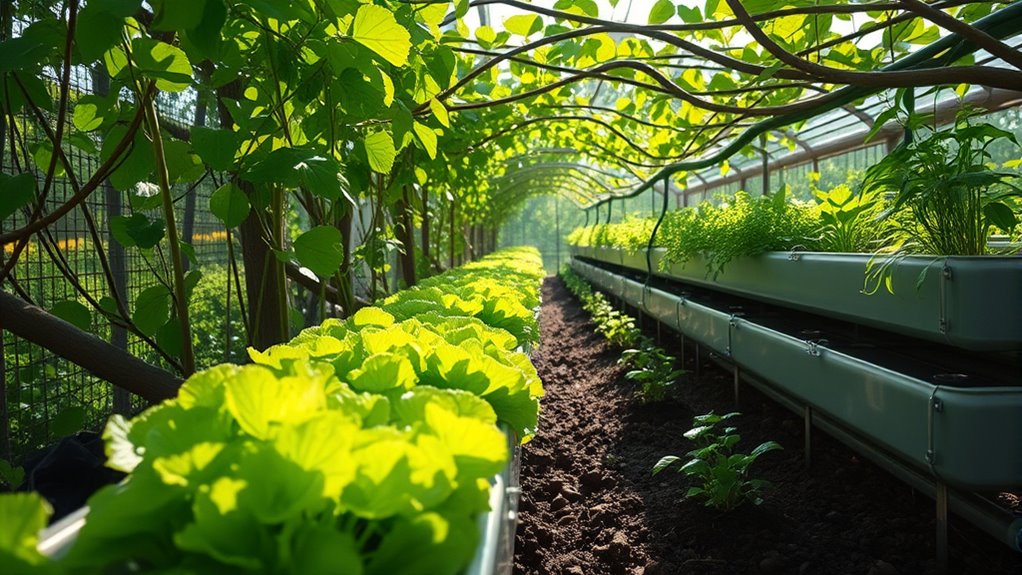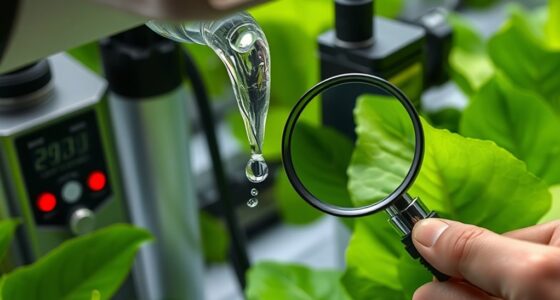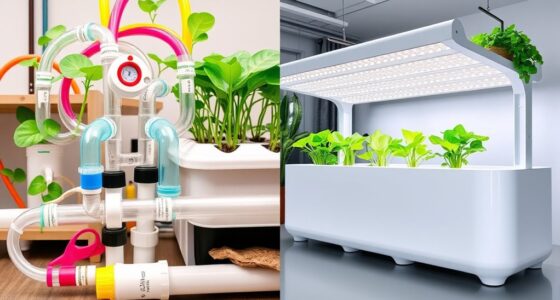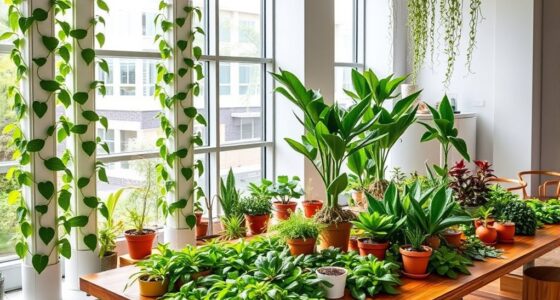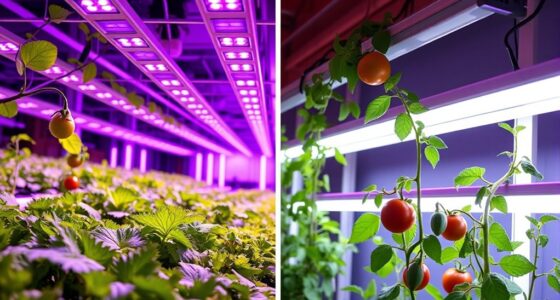To grow hydroponically off-grid without electricity, focus on gravity-driven systems that rely on height differences to circulate nutrients naturally. You can use wicking materials, capillary action, or simple flow-through containers to deliver water to your plants. Incorporate natural filtration and environmental controls, like sunlight and passive ventilation, to maintain water quality and plant health. If you explore these passive methods further, you’ll discover how to create efficient, low-maintenance gardens that thrive without power.
Key Takeaways
- Utilize gravity-driven passive hydroponic systems, such as flood-and-drain or wicking setups, to eliminate electrical reliance.
- Position reservoirs higher than plant beds to create natural water flow through height differences.
- Incorporate natural capillary action using fabrics or tubes for continuous moisture delivery without pumps.
- Use simple, repurposed containers and natural filtration methods to maintain water quality and reduce maintenance.
- Monitor water levels and pH regularly to ensure optimal plant health in off-grid, passive hydroponic systems.
Understanding Passive Hydroponic Principles
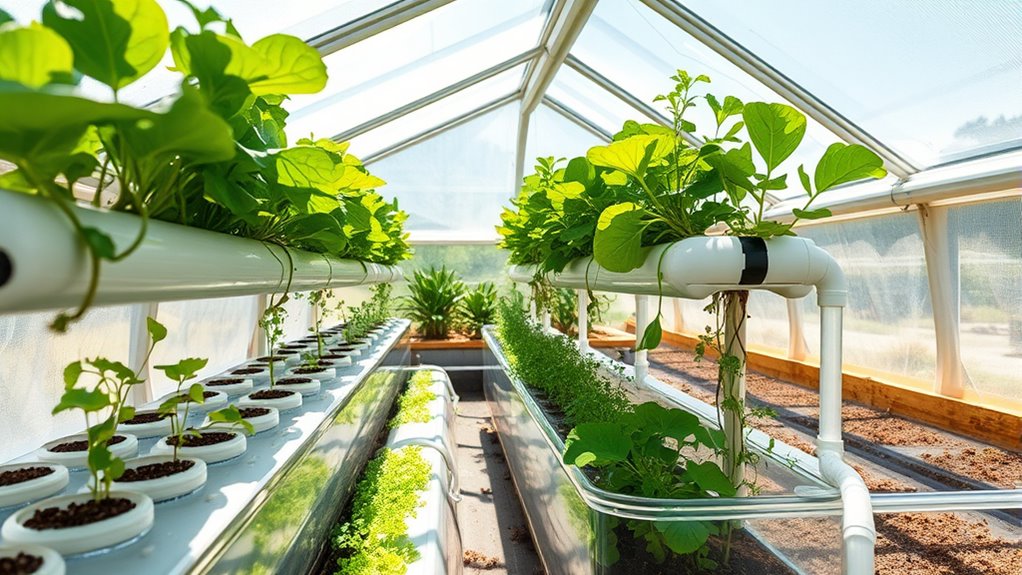
Passive hydroponic gardening relies on simple, gravity-driven systems that don’t require pumps or electricity. You harness natural flow to deliver nutrients directly to plant roots, which helps maintain ideal soil health by preventing overwatering and root rot. Because these systems use clean, circulating water rather than soil, pest management becomes easier—fewer soil-borne pests threaten your plants. You don’t need chemical pesticides, and the controlled environment keeps pests at bay naturally. Understanding these principles helps you create a sustainable setup that supports plant growth without electricity. By focusing on gravity, you guarantee a steady nutrient supply, keep soil healthy, and reduce pest issues, making your off-grid garden more resilient and low-maintenance. Proper water circulation is essential to ensure consistent nutrient delivery and prevent stagnation in passive systems.
Selecting the Right System for Off-Grid Gardening

Choosing the right hydroponic system for your off-grid garden depends on your space, budget, and plant needs. Consider how different systems handle aeroponics challenges and nutrient solution stability. To help you decide, think about:
- Space efficiency—will your plants thrive in compact or larger setups?
- Maintenance needs—are you prepared for systems that require frequent monitoring?
- Resource constraints—which systems work best without electricity?
- Growth potential—will your chosen system support your plant variety and yield goals?
Passive systems like wicking or flood-and-drain can minimize aeroponics challenges and maintain nutrient stability without power. Your choice should balance ease, reliability, and your specific off-grid environment. Additionally, understanding hydroponic nutrient management can help optimize your system’s performance and plant health.
Designing Gravity-Driven Nutrient Delivery Methods

When designing gravity-driven nutrient delivery methods, the key is to leverage natural weight differences to move solutions without relying on pumps or electricity. In vertical farming setups, position nutrient reservoirs higher than your plant beds to create a consistent flow through gravity. If you incorporate aquaponic integration, ensure fish tanks are elevated so nutrient-rich water naturally cascades into grow beds. Use simple piping and adjustable outlets to control flow rates, maintaining steady nutrient delivery. This passive approach minimizes energy needs and keeps systems reliable off-grid. Proper planning involves calculating height differences and flow paths to ensure even distribution. Additionally, incorporating mindfulness techniques can help you stay attentive to system performance and quickly identify any issues. By combining vertical farming principles with aquaponic integration, you can optimize nutrient flow efficiently and sustainably, creating a self-sufficient hydroponic system that thrives without electricity.
Utilizing Capillary Action With Wicking Materials
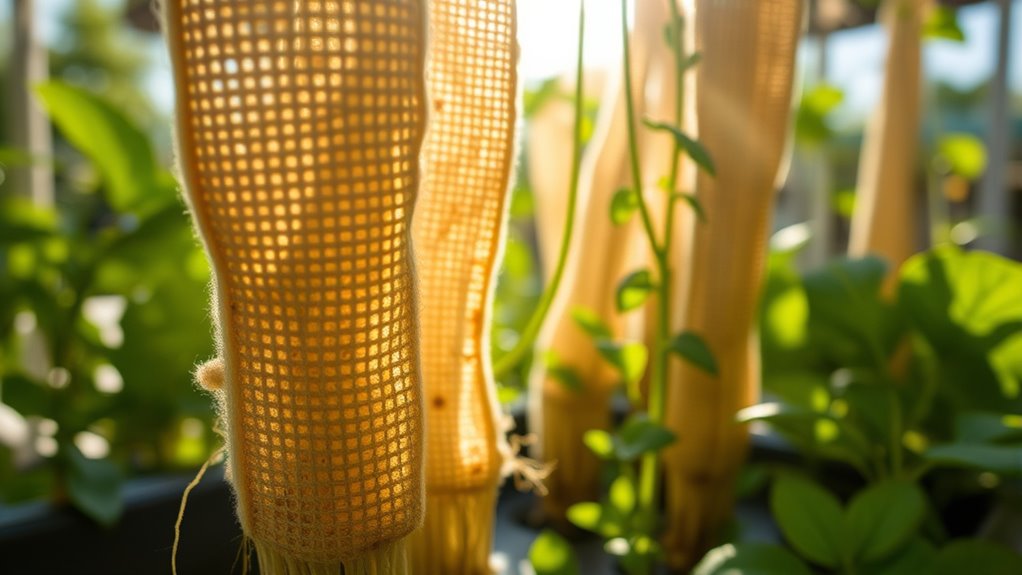
Have you considered how capillary action can naturally deliver nutrients to your plants? Wicking fabrics and capillary tubes draw water upward effortlessly, providing a reliable supply without electricity. This passive method keeps your plants consistently moist and healthy. Here are four reasons to embrace capillary action:
- Simplicity—no pumps or power needed.
- Reliability—steady nutrient delivery through natural wicking.
- Versatility—works with various wicking fabrics and capillary tubes.
- Cost-efficient—minimal materials mean affordable gardening.
Using wicking fabrics or capillary tubes, you can create a passive system that feeds your plants continuously. This approach harnesses natural forces, making off-grid gardening easier and more sustainable. It’s an elegant solution for thriving hydroponic setups without electricity. Additionally, understanding the horsepower of electric dirt bikes can inspire the design of lightweight, high-efficiency systems for off-grid gardening.
Building Simple Passive Containers and Reservoirs
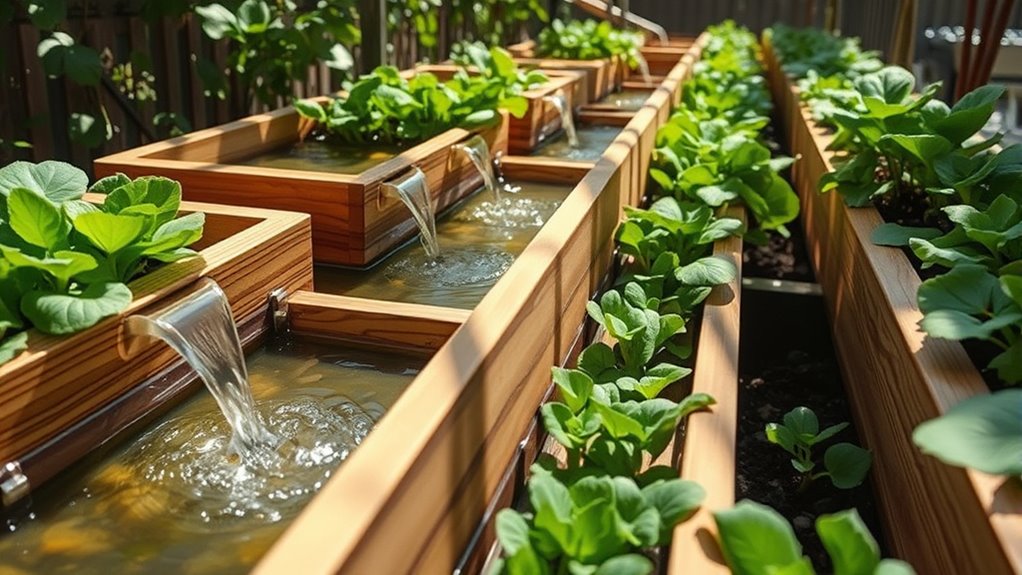
Building simple passive containers and reservoirs is a straightforward way to create an efficient hydroponic system. You can repurpose old containers or buckets, assuring they’re clean and food-safe. These reservoirs hold nutrient solutions, like compost tea, which nourishes your plants naturally. Use materials that prevent pests and are easy to access for maintenance. To keep pests at bay, add physical barriers or natural repellents. Regularly check water levels and pH to maintain plant health. For added stability, include a simple overflow system to prevent spills. Here’s a quick overview:
| Container Type | Material | Maintenance Tips |
|---|---|---|
| Plastic Bucket | Food-safe plastic | Clean regularly, avoid pests |
| Large Jar | Glass or acrylic | Check for cracks, pest-proof |
| Wood Box | Treated wood | Prevent rot, pest control |
| Upcycled Tubs | Repurposed | Ensure watertight, pest-free |
| Metal Container | Aluminum or steel | Prevent corrosion, pest prevention |
This setup promotes healthy growth and minimizes pest issues, especially when combined with proper sanitation practices.
Choosing Suitable Plants for Passive Systems

Selecting the right plants for passive hydroponic systems guarantees healthy growth and efficient nutrient use. You’ll want plants that thrive with minimal intervention and adapt well to passive setups. Consider these options:
- Succulent species – drought-tolerant and low-maintenance, they flourish in passive environments.
- Leafy greens – fast-growing and nutrient-hungry, perfect for consistent harvests.
- Herbs like basil and mint – aromatic, easy to grow, and adaptable to passive systems.
- Strawberries – resilient and rewarding, they can thrive with minimal support.
Choosing plants suited for passive systems assures your off-grid garden stays productive and vibrant. Focus on species that require less frequent watering and can handle fluctuating nutrient levels, aligning with the principles of self-sufficient gardening, maximizing your success in off-grid gardening.
Optimizing Light and Environment Without Electricity

Maximizing natural light and creating an ideal environment are essential for thriving passive hydroponic systems without electricity. Position your plants to receive ample sunlight, using south-facing windows or open structures to enhance light exposure. Proper airflow helps regulate temperature and humidity, supporting healthy plant propagation. Shade delicate seedlings during the hottest parts of the day to prevent stress, and incorporate natural barriers like shade cloths or taller plants to manage light levels. Good airflow also reduces excess humidity, decreasing pest and disease risks. Keep your environment clean and monitor for pests, employing natural pest management strategies such as neem oil or companion planting. By optimizing light and environment, you set a solid foundation for healthy plant growth and effective pest control, ensuring your passive hydroponic system thrives without electricity. Additionally, understanding the importance of attention in creative practice can help you stay focused on optimizing your growing conditions and troubleshooting issues as they arise.
Maintaining Nutrient Levels and Water Quality

To keep your hydroponic system healthy, you’ll want to use natural filtration methods like gravel or biofilters to maintain water clarity. Regular nutrient testing guarantees your plants get the right balance, preventing deficiencies or excesses. Don’t forget to schedule water changes to keep the environment fresh and boost plant growth. Additionally, monitoring the water quality ensures optimal conditions for your plants’ development.
Natural Filtration Methods
Natural filtration methods play a vital role in maintaining healthy nutrient levels and water quality in passive hydroponic systems. You can harness biofiltration techniques to naturally purify water, encouraging microbial nutrient breakdown that keeps the system balanced. These methods prevent harmful buildup and guarantee your plants receive clean, nutrient-rich water.
Consider these effective natural filtration strategies:
- Using gravel or sand beds to trap debris and promote beneficial microbial growth.
- Incorporating floating aquatic plants that absorb excess nutrients and improve water clarity.
- Establishing biofilters with organic materials like coconut husks to foster microbial activity.
- Relying on slow water flow to naturally aerate and filter water through microbial communities.
These methods foster a healthy environment, supporting your off-grid gardening success.
Regular Nutrient Testing
Regular nutrient testing is essential for keeping your passive hydroponic system balanced and healthy. Consistently monitoring water quality helps you maintain proper pH balancing, ensuring nutrients are available for your plants. When pH levels are off, plants can become stressed, which increases vulnerability to pathogens. Regular testing allows you to catch issues early and adjust nutrient concentrations accordingly. Use simple testing kits to check pH and nutrient levels regularly, ideally weekly. Keeping water within ideal pH ranges not only promotes healthy growth but also prevents the development of harmful pathogens that thrive in unbalanced conditions. By staying vigilant with nutrient testing, you ensure your plants receive consistent nourishment, leading to a more productive and resilient hydroponic system.
Water Change Strategies
Maintaining ideal water quality in a passive hydroponic system requires strategic water change practices. Properly managing water guarantees your plants receive consistent nutrients and stay healthy. To do this effectively:
- Regularly monitor water nutrient levels and adjust through aquaponic integration for a balanced ecosystem.
- Implement periodic partial water changes to prevent buildup of toxins and maintain water clarity.
- Use natural filtration methods to promote water oxygenation and reduce algae growth.
- Consider automated dosing systems that work without electricity, helping you maintain stable nutrient concentrations effortlessly.
- Incorporating passive hydroponic techniques can further enhance water efficiency and system sustainability.
Troubleshooting Common Challenges in Passive Setups
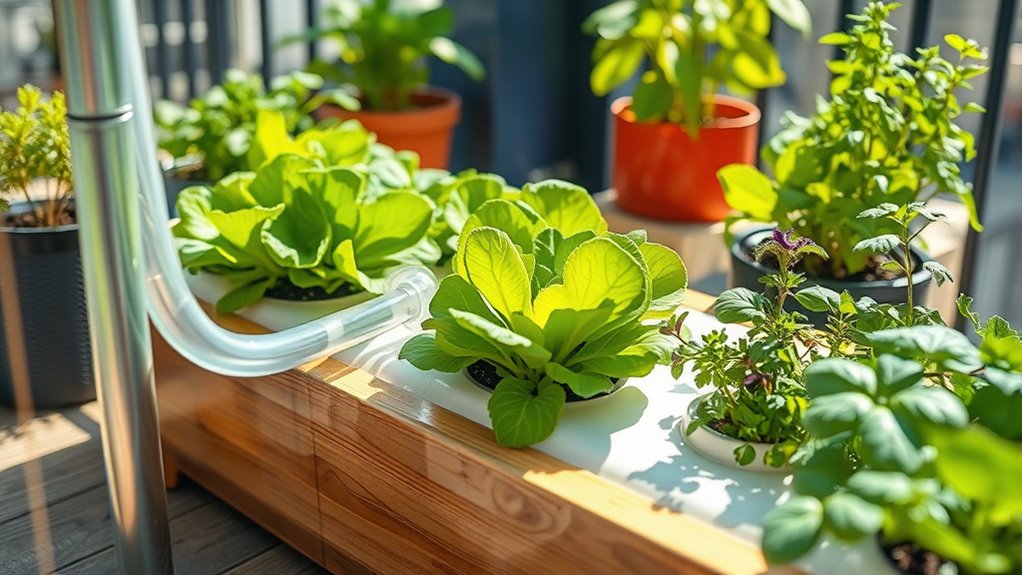
Passive hydroponic systems can face several common challenges that may hinder plant growth, but many issues are easily identified and addressed with some troubleshooting. One frequent problem is pests, which can damage plants and spread disease. Effective pest management and pest control involve inspecting plants regularly, removing affected foliage, and encouraging natural predators like ladybugs. Confirm your system isn’t attracting pests by keeping the environment clean and free of debris. Additionally, monitor for signs of mold or algae, which can indicate imbalances in moisture or nutrients. Properly sealing containers and using natural deterrents can prevent pest infestations. Choosing appropriate portable gardening equipment can also help maintain optimal conditions and prevent issues before they arise. By staying vigilant and maintaining a clean, balanced environment, you can minimize pests and keep your passive hydroponic setup thriving.
Tips for Scaling and Extending Your Off-Grid Garden
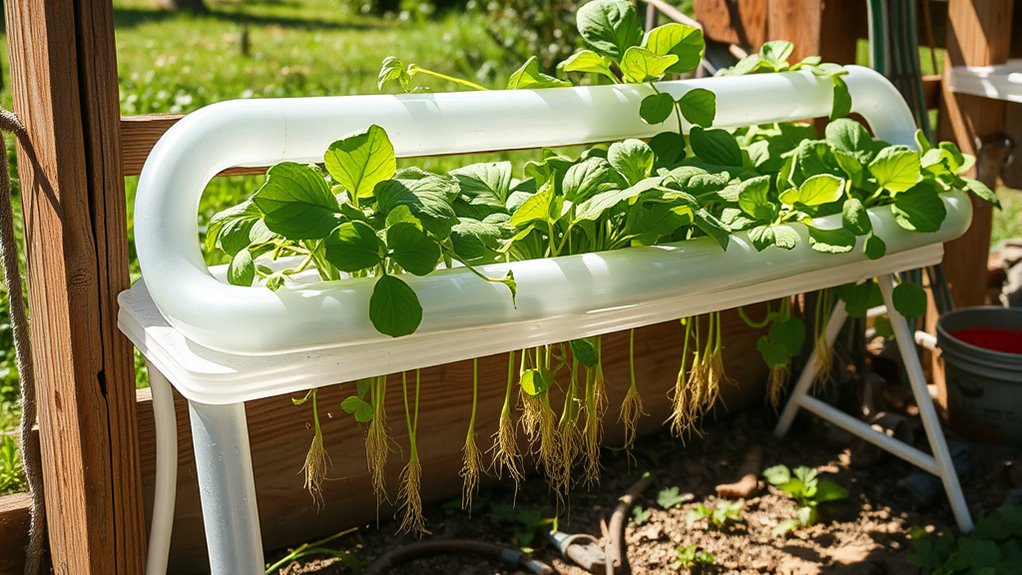
Scaling and extending your off-grid garden requires thoughtful planning to make certain your passive hydroponic system continues to thrive as you expand. Focus on maintaining nutrient balance by using compost tea to boost plant health naturally. Implement effective pest management techniques, like companion planting or physical barriers, to protect your crops without chemicals. When increasing your setup, consider modular designs that can grow with your needs, ensuring easy expansion. Keep a close eye on water flow and nutrient levels to prevent bottlenecks. Use organic amendments and natural pest controls to keep your system sustainable. Additionally, monitor pinball machine weights to ensure your infrastructure can support expanded setups, especially if incorporating larger or heavier components. With careful planning, your garden can flourish far beyond its initial size, providing fresh produce while staying true to off-grid principles.
Frequently Asked Questions
How Do Passive Hydroponic Systems Handle Pests and Diseases?
You can manage pests and diseases in passive hydroponic systems by using biological pest control methods, like introducing beneficial insects or natural predators. Additionally, selecting disease-resistant crops helps prevent common issues. Good sanitation, proper airflow, and crop rotation also reduce risks. These natural strategies keep your system healthy without chemicals or electricity, ensuring your plants thrive while maintaining an eco-friendly, off-grid setup.
Can Passive Systems Support All Types of Vegetables and Herbs?
You can grow many types of vegetables and herbs in passive systems, but not all thrive equally. Focus on pest-resistant varieties and use companion planting to naturally deter pests. While leafy greens and herbs often do well, root vegetables may need different conditions. Adjust your plant choices based on your climate and soil or growth medium. With proper planning, passive systems can support a diverse, healthy garden.
What Are the Best Materials for Building Long-Lasting Passive Containers?
Your passive containers are the backbone of your garden, so choosing the right materials is essential. For unmatched container durability, opt for high-density polyethylene or glass, which resist weather and wear. Bamboo and recycled wood are sustainable choices that last if treated properly. These materials blend durability with sustainability, ensuring your garden’s success while protecting the environment—making your off-grid setup truly legendary.
How Often Should Nutrient Solutions Be Replenished in Passive Setups?
You should check your nutrient solution regularly, roughly every two to three weeks, to maintain ideal fertilizer schedules. Replenish the reservoir when you notice nutrient levels dropping or pH shifting outside suitable ranges. Consistent reservoir maintenance ensures your plants get the right nutrients and prevents issues like algae growth or salt buildup. Staying attentive to these factors helps keep your passive hydroponic system healthy and productive.
Are Passive Hydroponic Systems Suitable for Extreme Weather Conditions?
Passive hydroponic systems can be somewhat weather resilient, but extreme conditions challenge their effectiveness. You should implement insulation strategies like wrapping containers or adding shade to protect plants from temperature fluctuations. Proper insulation helps maintain stable root zones and prevents damage. While passive systems have limits in severe weather, combining insulation and strategic placement can improve their resilience, making them more suitable for off-grid living in diverse climates.
Conclusion
Did you know that passive hydroponic systems can reduce water usage by up to 90% compared to traditional soil gardening? By designing gravity-driven flow and capillary action, you can grow fresh produce off-grid without electricity. With some simple materials and careful planning, you’ll enjoy sustainable, low-maintenance gardening all year round. Embrace these passive methods and transform your off-grid space into a thriving, eco-friendly food source—no power needed!
